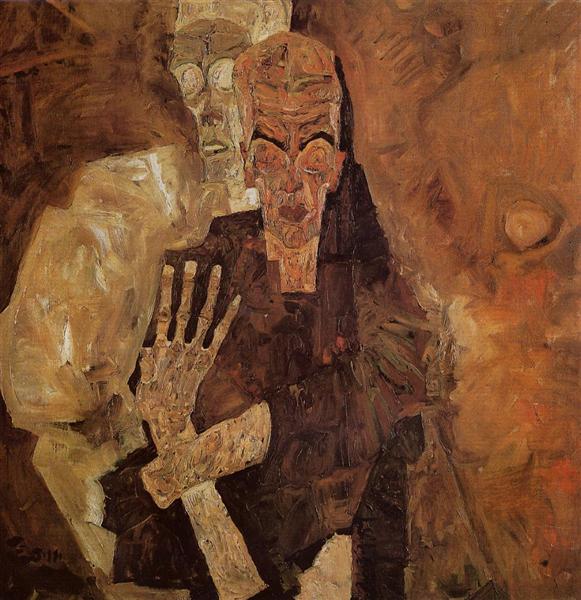Description
The work "The seers (death and man)" by Egon Schiele, painted in 1911, is erected as a forceful testimony of the disturbing and radical aesthetic of expressionism, a movement that Schiele not only hugged, but also defined through of a unique fusion of emotion, shape and color. Through this work, the artist explores the duality of human existence, a recurring theme in his work, which tends to challenge the traditional notions of art and the representation of the body.
The composition of "the seers" presents two human figures whose intertwining expresses both the vulnerability and the inevitability of death. In this painting, the use of color plays a leading role; Earth's tones and acute contrasts accentuate the despair and intimacy of the scene. The dark background seems to absorb the characters, contributing a sense of depth and gravitation towards the central theme: the relationship between man and death. This clear contrast between the shadow tones and the most vibrant nuances in the bodies of the figures creates a visual tension that reflects the internal struggle of their stocks.
The figures are represented in a way that escapes idealization and enters the crude emotional realism. One of the figures seems to be in a state of introspection or reflection, while the other, more attenuated by life, manifests itself as a tangible reminder of mortality. This ambiguity causes a powerful emotional resonance, allowing the viewer to immerse itself in the exploration of its own existence and mortality. The disposition of the figures, close but distant, invites the interpretation of the viewer, who can see in them a mirror of their own fears and desires.
Historically, Egon Schiele was a radical in his time, his works cover an emotional and psychological range that is usually disturbing, although undeniably fascinating. He himself was a pioneer of self -portrait and self -exploration, an evident feature in his own use of color and shape. Its style, characterized by strong lines and exaggerated contours, seeks to bring to the surface the intensity of human emotions, an aspect that clearly manifests itself in "seers."
Compared to other works of his time, such as "Las Les" or "El Hug", "The seers" stands out for their most explicit exploration of morbidity and the physical existence of the human being. Schiele, like his contemporaries, sought to break the idealization of the body and the traditional representation of the human being, but in this work specifically, he seems to have reached a raw and sincere encounter with the reality of death, a theme that in his work in his work It becomes a constant contemplation.
The seers, although less known than some of their other important works, encapsulates Schiele's essence: the search for raw truth of human existence. Through the exploration of death and introspection, this painting not only serves as a reflection of the artist's own internal conflict, but also invites the audience to contemplate the fragility and depth of the human condition. The interaction between the figures and the emotional context in which they are located makes this work a sublime example of the power of art to evoke deep reflections on life, death and everything that mediates between them.
KUADROS ©, a famous paint on your wall.
Hand-made oil painting reproductions, with the quality of professional artists and the distinctive seal of KUADROS ©.
Art reproduction service with satisfaction guarantee. If you are not completely satisfied with the replica of your painting, we refund your money 100%.

